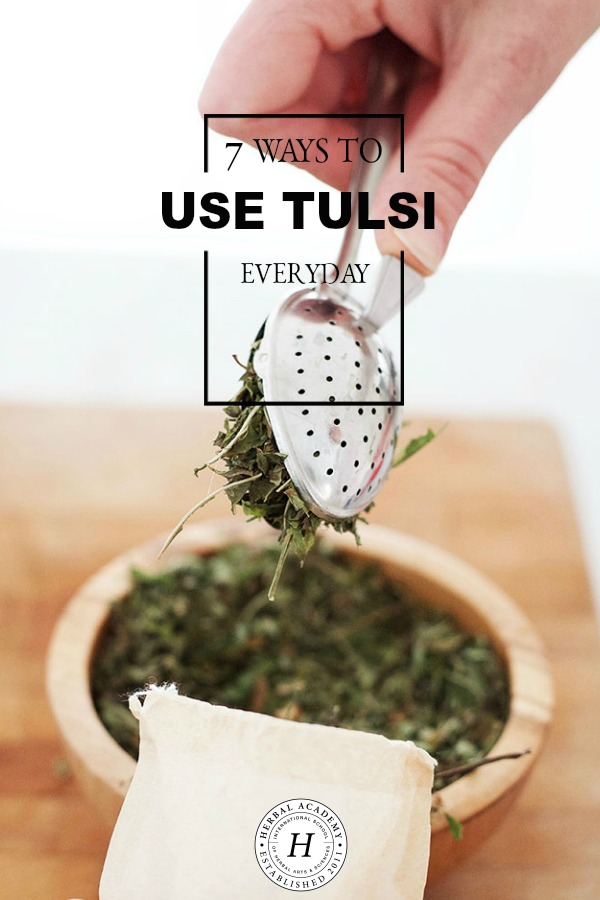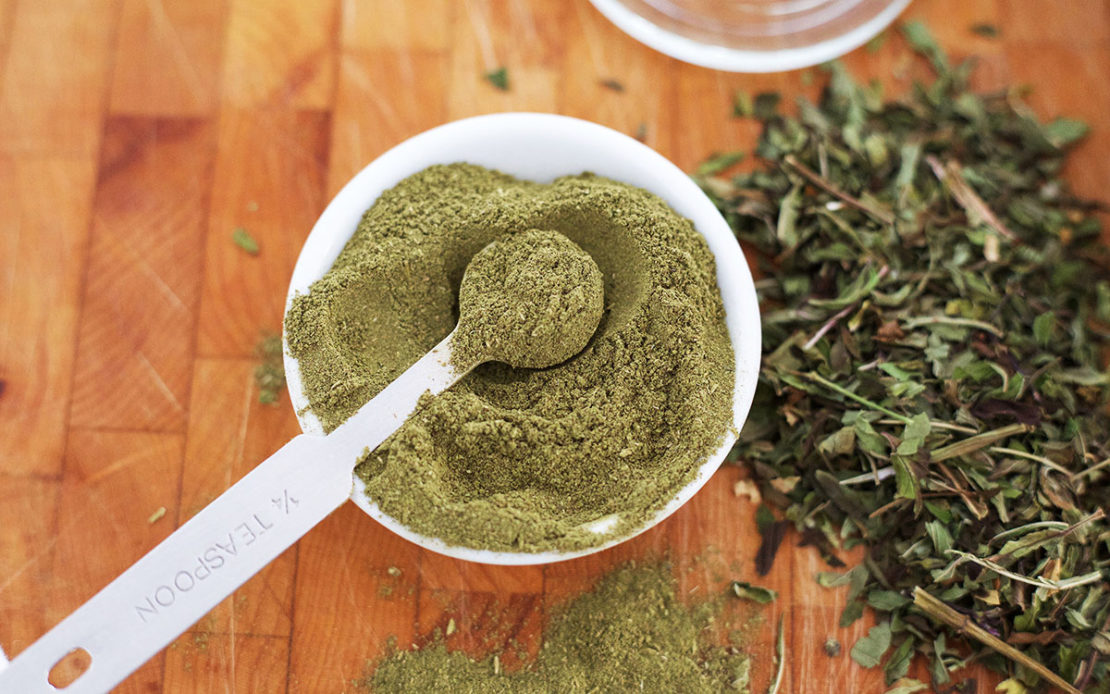
7 Ways To Use Tulsi Everyday
There is a reason why “holy basil” is another common name for tulsi (Ocimum sanctum). Hindu culture even considers tulsi to be “The Queen of the Herbs” and a manifestation of the goddess Lakshmi in plant form (Krishna & Amirthalingam, 2014). But why exactly is tulsi considered to be so sacred?
With an abundance of clinical applications and health-supportive properties that have been applied in Ayurveda for thousands of years, tulsi has been shown to nourish body, mind, and spirit through balancing and protecting against stress in the body (Cohen, 2014). Now, tulsi is steadily becoming a more popular herb around the world. How can you incorporate tulsi into your life? Read on to discover 7 simple ways you can use tulsi every day at home.
7 Ways to Use Tulsi Everyday

1. As an Adaptogenic Tea
Tulsi is considered to have mild adaptogenic properties and can be enjoyed daily as a tea. An adaptogen is an herb that helps support a healthy stress response by balancing different processes in the body including the hormonal cascade, how the immune system functions, and brain chemistry. This helps bring the body back into balance when you feel like things have gone off track. For instance, if you notice you are reacting to a stressful event instead of responding to it, you experience migraines from the same triggering comment your spouse makes every time, or your appetite shuts off for the entire week a proposal is due.
In this sense, tulsi can directly help the body “adapt” to physical, chemical, metabolic, and psychological stressors (Cohen, 2014). You can utilize the adaptogenic properties of tulsi by drinking it daily or as needed acutely in stressful situations. Since tulsi is also a powerful nervine, it can help stabilize and restore a frayed nervous system.
1 cup water A crucial reminder: Adaptogens should not be substituted for healthy lifestyle practices such as good sleep habits, exercise, and diet. Having a daily cup of tulsi tea is a powerful adjunct to these necessary self-care practices.
Used in Indian ceremonies as a holy plant for over 5,000 years, tulsi is a powerful herb to keep in your home or personal space. A “tulsi puja” is a daily practice performed in Hindu tradition to protect the energy of one’s house and keep it pure. A tulsi plant is grown and maintained in the house and every morning a prayer is said in front of the plant by offering water, smudging, sounds, and burning incense.
Cultivating a plant like this in your own home also helps foster a sense of connection to nature’s creative powers (Krishna & Amirthalingam, 2014). One way to use tulsi everyday is to try growing and caring for a tulsi plant in your home or garden to connect with it on a deeper level, both spiritually and physically. Tulsi is a fairly easy plant to grow and cultivate. Although it typically thrives in a humid climate it can still be successfully grown in dry climates, both indoors and outdoors. Since it is in the mint plant family (Lamiaceae), you can pinch off the inflorescence right above the first set of leaves as soon as it shows signs it is about to flower. This encourages the plant to continue producing leaves and grow into a more bushy habit. Learn more about growing tulsi from seed here.
Not in the place to care for a houseplant? Not a problem! You can also wear tulsi as a protective talisman or place on your altar. Just as tulsi can protect against toxic accumulation in the body and protect the energy of your home, it can also be used to protect your own personal energy and physical body.
Try taking a couple sprigs of fresh tulsi, or a handful of the dried leaves, and place them on your altar with an intention or prayer. You can also take a small pinch of tulsi and wear it in a pouch around your neck as a talisman for protection. Traditionally, women would foster the energy of positive attachment by wearing the stems of tulsi as a rosary (Lad, 1986).
While you may have already spotted tulsi in the ingredients list on your natural toothpaste, but did you know that tulsi’s broad-spectrum antibacterial and anti-inflammatory actions make it a truly effective mouthwash as well? One clinical trial demonstrated that using tulsi extract as a mouthwash is as effective in reducing Streptococcus mutans, a bacteria responsible for tooth decay, as 0.2% Chlorhexidine and Listerine (Agarwal & Nagesh, 2011). If you use tulsi everyday as an oral rinse, it has the potential to help clear plaque and bacteria build-up in the mouth (Hosamane et al., 2014).
1 handful (about 1/2 cup, packed) fresh tulsi leaves (or 2 tablespoons dried tulsi leaves) Tulsi demonstrates anti-depressive and anxiety-regulating effects which can positively impact our cognitive function and memory (Cohen, 2014). Commonly used as a nervine, or an herb that helps regulate and balance the nervous system, tulsi is believed to strengthen the nerve tissue. A simple, traditional preparation to promote clarity of mind is to prepare the tea with honey (Lad, 1986).
Curious to try a brain tonic formula with tulsi at home? Check out our New Year’s Herbal Tonic Recipe here.
A traditional Ayurvedic preparation of using tulsi everyday is to take dried tulsi powder and mix it into a spoonful of ghee, oil, or honey. It is reported that this preparation slows the assimilation of the herb by carrying it further down the digestive tract, as opposed to simply taking a capsule of the herb (P. Bergner, personal communication, 2016). The solvent of ghee or honey also offers a harmonizing action for the slight bitterness and drying action of the dried tulsi leaf.
½ teaspoon ground tulsi leaf powder You can also prepare a tulsi-infused honey via a longer infusion method using either dry or fresh herb. Read our post here for step-by-step instructions on making simple herbal honey recipes.
The fresh leaves of tulsi can actually be consumed as a juice! This tasty and refreshing method of using tulsi is profoundly rejuvenating for the immune system. Traditionally, the juice is mixed with honey to resolve colds, fevers, and respiratory issues. Drinking the juice of tulsi can also help the body adapt to stress by bringing balance to different processes of the body (Krishna & Amirthalingam, 2014). You can also use the fresh leaf juice externally as a poultice for fungal infections on the skin (Lad, 1986).
1/2 cup water This one is simple! If you care for a tulsi plant in your home or garden, having access to the fresh leaves in abundance is natural. Eating the fresh leaves of tulsi is an amazing way to boost your immunity. In India, a common practice is to chew 3-4 leaves first thing in the morning on an empty stomach to help boost the immune system. While you can simply swallow the leaves whole in a big gulp of water, chewing is recommended to help release phytonutrients.
Are you ready to use tulsi everyday?
Tulsi is an ancient, powerful, yet gentle herb with many supportive uses that can fit easily into your everyday life! Whether you use tulsi as a tea or infused honey for your own personal health or grow it to protect your home, we hope that this article has inspired you to use tulsi everyday in your home.
REFERENCES
Agarwal, P. & Nagesh, L. (2011). Comparative evaluation of efficacy of 0.2% Chlorhexidine, Listerine and tulsi extract mouth rinses on salivary Streptococcus mutans count of high school children—RCT. Contemporary Clinical Trials, 32(6), 802-8.
Cohen, M.M. (2014). Tulsi – Ocimum sanctum: A herb for all reasons. Journal of Ayurveda and Integrative Medicine, 5(4), 251-259.
Hosamane, M., Acharya, A.B., Vig, C., Trivedi, D., Setty, S., & Thakur, S.L. (2014). Evaluation of holy basil mouthwash as an adjunctive plaque control agent in a four day plaque regrowth model. Journal of Clinical and Experimental Dentistry, 6(5), e491–e496. http://doi.org/10.4317/jced.51479
Krishna, N. & Amirthalingam, M. (2014). Sacred plants of India. UK: Penguin.
Lad, V. & Frawley, D. (1986). The yoga of herbs: An Ayurvedic guide to herbal medicine. Twin Lakes, WI: Lotus Press.
Rätsch, C. & Müller-Ebeling, C. (2013). The encyclopedia of aphrodisiacs: Psychoactive substances for use in sexual practices. Rochester, VT: Park Street Press.
Adaptogenic Tulsi Tea
1-2 tablespoons dried tulsi (or a handful of fresh tulsi leaves and flowers)
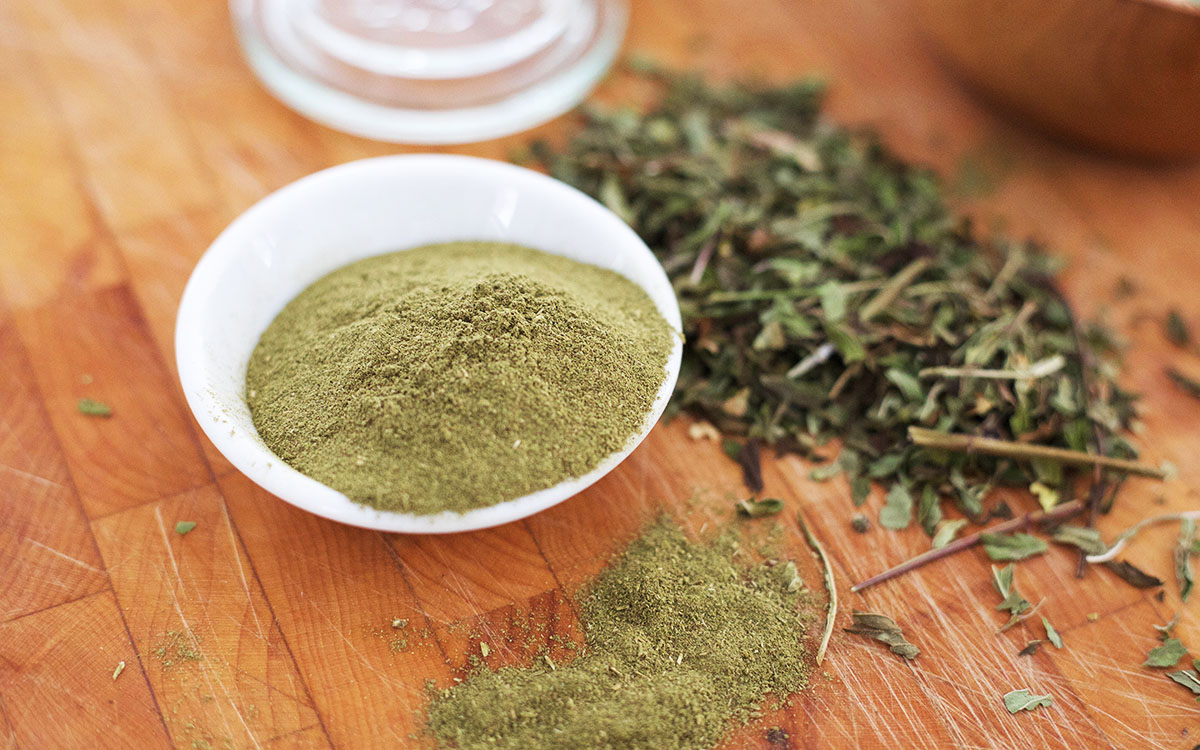
2. As a House Protector
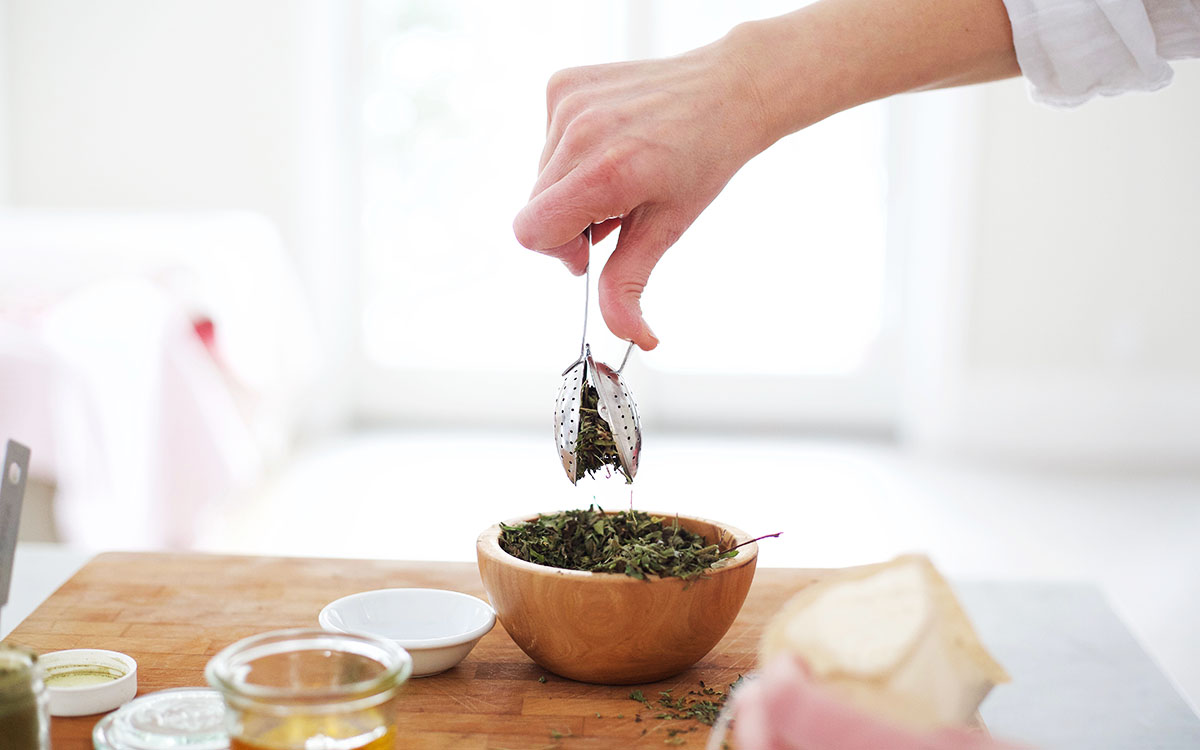
3. As a Mouthwash
Basic Tulsi Mouthwash
1 cup water
optional: 1 teaspoon vodka
4. As a Brain Tonic
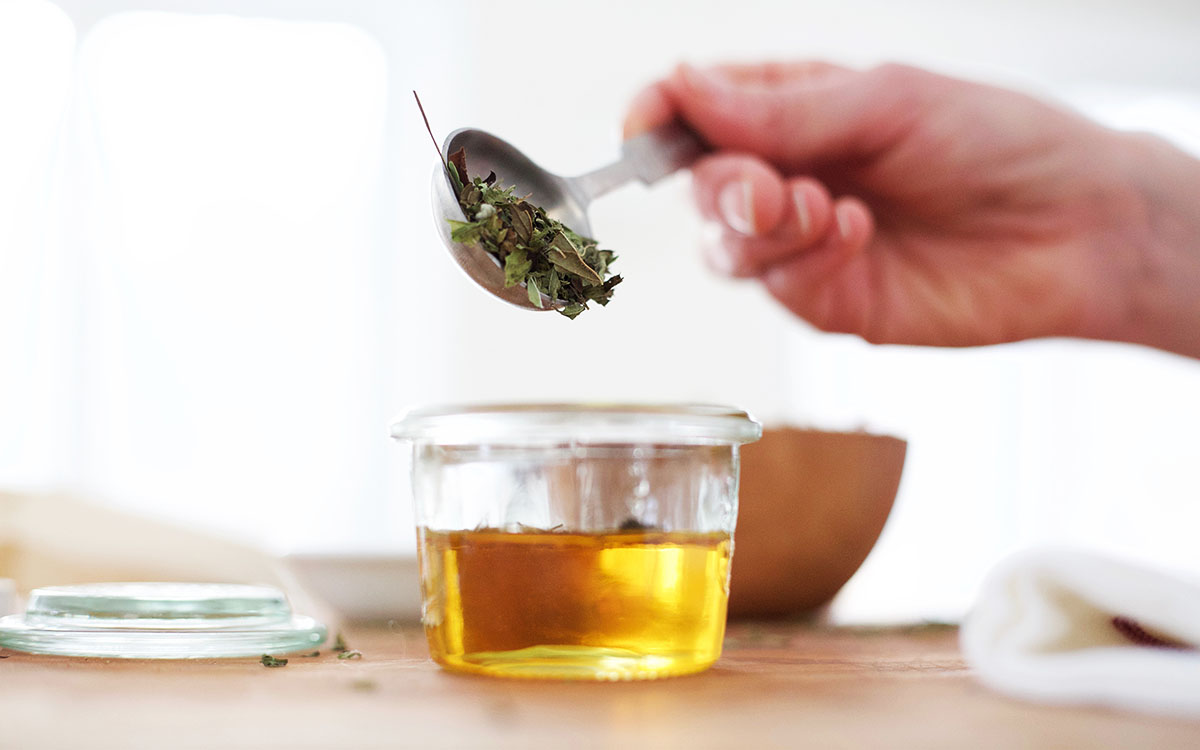
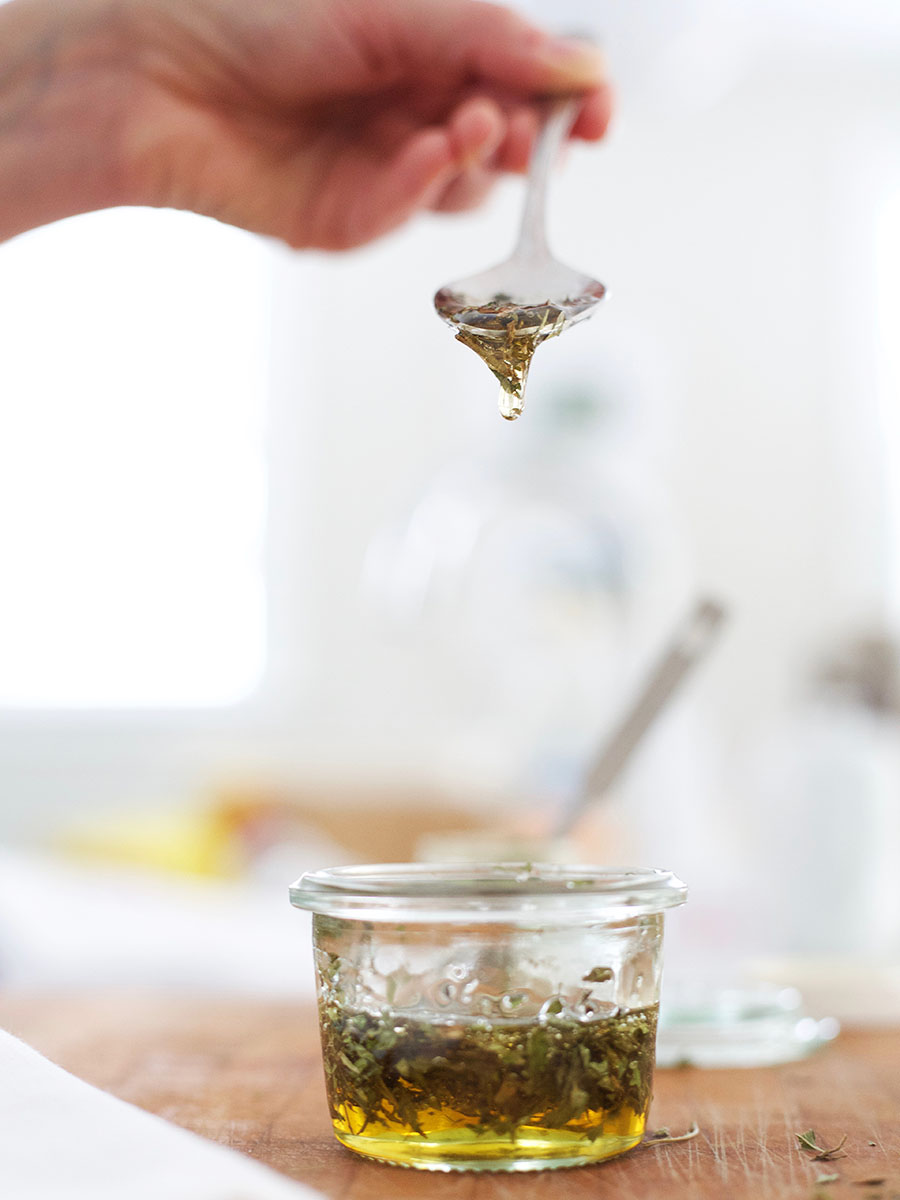
5. As an Infused Ghee or Honey
Tulsi Paste
1-2 teaspoons ghee, oil, or honey
6. As a Fresh Juice
Fresh Tulsi Juice
1 cup fresh tulsi leaves
7. By Eating the Fresh Leaves
